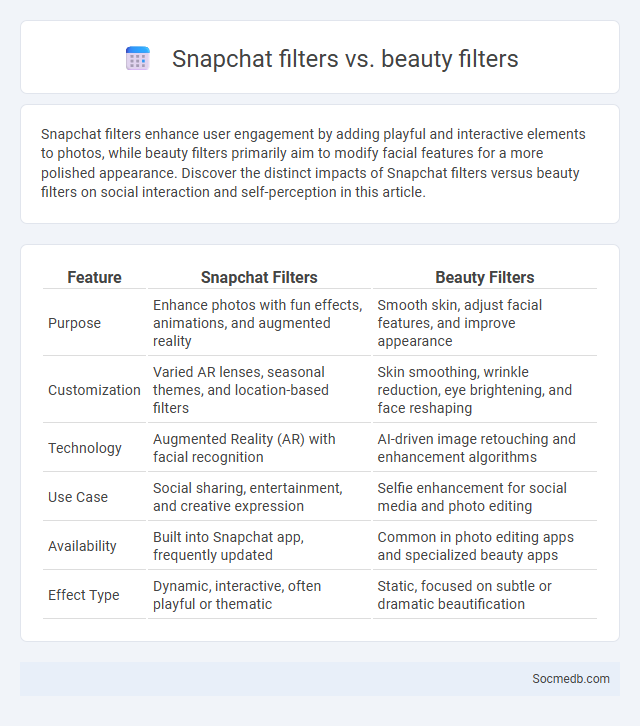
Photo illustration: Snapchat filters vs beauty filters
Snapchat filters enhance user engagement by adding playful and interactive elements to photos, while beauty filters primarily aim to modify facial features for a more polished appearance. Discover the distinct impacts of Snapchat filters versus beauty filters on social interaction and self-perception in this article.
Table of Comparison
| Feature | Snapchat Filters | Beauty Filters |
|---|---|---|
| Purpose | Enhance photos with fun effects, animations, and augmented reality | Smooth skin, adjust facial features, and improve appearance |
| Customization | Varied AR lenses, seasonal themes, and location-based filters | Skin smoothing, wrinkle reduction, eye brightening, and face reshaping |
| Technology | Augmented Reality (AR) with facial recognition | AI-driven image retouching and enhancement algorithms |
| Use Case | Social sharing, entertainment, and creative expression | Selfie enhancement for social media and photo editing |
| Availability | Built into Snapchat app, frequently updated | Common in photo editing apps and specialized beauty apps |
| Effect Type | Dynamic, interactive, often playful or thematic | Static, focused on subtle or dramatic beautification |
Understanding Filters: An Overview
Filters on social media platforms enhance your visual content by adjusting colors, brightness, and contrast to create a specific mood or aesthetic. Understanding how different filters influence audience perception can improve your engagement and brand consistency. Choosing the right filter aligns your posts with your intended message, making your social media presence more compelling.
What Are Snapchat Filters?
Snapchat filters are augmented reality effects that enhance your photos and videos by adding animations, graphics, and visual transformations in real-time. These filters utilize facial recognition technology to apply changes such as altering facial features, adding accessories, or overlaying themed animations that reflect current trends or events. By using Snapchat filters, you can personalize your snaps to create engaging and visually appealing content that stands out on social media platforms.
Defining Beauty Filters
Beauty filters on social media platforms use advanced algorithms and augmented reality to enhance facial features by smoothing skin, brightening eyes, and reshaping contours, creating an idealized appearance. These filters leverage machine learning to analyze and modify images in real-time, often promoting a standardized notion of beauty. The widespread use of beauty filters influences self-perception and social interactions by shaping users' expectations of attractiveness and visual norms.
General Filters Explained
General filters on social media platforms enhance your content discovery by sorting posts based on relevance, date, or popularity. These filters allow you to customize your feed, ensuring that the most pertinent and engaging content appears first. Using general filters effectively improves your browsing experience and helps you stay updated with trends and topics that matter most to you.
Key Differences Among Filters
Social media filters vary primarily in functionality, including beauty enhancements, AR effects, and color adjustments, each tailored to different user experiences. Beauty filters smooth skin, brighten eyes, and alter facial features for a polished look, while AR filters overlay 3D objects or animations to create immersive effects. Color filters adjust tones and moods of images, influencing visual storytelling and engagement by enhancing lighting, contrast, or applying stylistic presets.
Impact on Self-Image and Confidence
Social media platforms significantly influence self-image by shaping users' perceptions through curated content and peer comparisons. Frequent exposure to idealized images can lead to decreased self-esteem and increased body dissatisfaction, particularly among adolescents and young adults. However, positive engagement and supportive online communities may enhance confidence by fostering a sense of belonging and validation.
Popular Uses for Each Filter Type
Instagram filters like Clarendon and Juno enhance colors and brightness, making photos more vibrant and appealing for lifestyle and travel posts. Snapchat filters often use augmented reality to add playful animations or beautify selfies, driving engagement through interactive storytelling and personalized effects. TikTok filters focus on trend-driven visual effects and facial recognition, encouraging creative expression and viral content in video formats.
Risks and Criticisms of Digital Filters
Digital filters on social media can distort reality, leading to unrealistic beauty standards and negatively impacting mental health, especially among young users. These filters often mask true appearances, promoting a culture of comparison and self-doubt that can harm Your self-esteem and body image. Privacy concerns also arise as some filters collect biometric data, exposing users to potential misuse and security risks.
Social Media Trends and Filters
Social media trends rapidly evolve, with short-form video content and augmented reality (AR) filters dominating user engagement in 2024. Popular platforms like Instagram and TikTok continuously update their AI-driven filters to enhance visual storytelling and personalized experiences. These innovations drive higher interaction rates, making AR filters a crucial tool for brands targeting Gen Z and Millennials.
The Future of Filters in Digital Media
Filters in digital media are rapidly evolving with advancements in augmented reality and AI, enhancing user engagement and personalized experiences across platforms like Instagram and Snapchat. These new-generation filters enable creators and brands to deliver immersive storytelling, blending real and virtual worlds seamlessly for Your audience. As AI-driven customization becomes more sophisticated, filters will play a pivotal role in shaping social interactions and marketing strategies in social media ecosystems.
 socmedb.com
socmedb.com